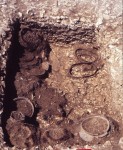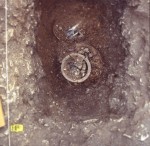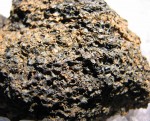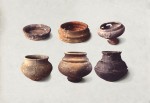 In 1979, an aerial survey found an extensive archaeological site in the town of Acy-Romance, 20 miles north of Reims in the Champagne-Ardenne region of northeastern France. Excavations began on the site in 1980 and continued until 1988, unearthing a complex of tombs and religious monuments dating from 1100 B.C. to 450 B.C. Between 1988 and 2003, archaeological teams staffed mainly by volunteers working on a shoestring budget focused on excavating the later Gallic village on the site. Despite their lack of resources and only being able to dig during the summer months, over time the researchers were able to excavate the entire village of 20 acres.
In 1979, an aerial survey found an extensive archaeological site in the town of Acy-Romance, 20 miles north of Reims in the Champagne-Ardenne region of northeastern France. Excavations began on the site in 1980 and continued until 1988, unearthing a complex of tombs and religious monuments dating from 1100 B.C. to 450 B.C. Between 1988 and 2003, archaeological teams staffed mainly by volunteers working on a shoestring budget focused on excavating the later Gallic village on the site. Despite their lack of resources and only being able to dig during the summer months, over time the researchers were able to excavate the entire village of 20 acres.
 Acy-Romance is one of the only completely excavated Gallic villages, and it is the only one where the full layout of the town is discernible. A great number of postholes show where houses were built, their size and therefore the social standing of their inhabitants. Grain pits, cemeteries, temples, and courtyards testify to not just the physical construction of the village, but also the political, cultural and social structures of the settlement.
Acy-Romance is one of the only completely excavated Gallic villages, and it is the only one where the full layout of the town is discernible. A great number of postholes show where houses were built, their size and therefore the social standing of their inhabitants. Grain pits, cemeteries, temples, and courtyards testify to not just the physical construction of the village, but also the political, cultural and social structures of the settlement.
 It appears that after around 400 B.C., the Iron Age inhabitants moved out. Although evidence suggests there were still scattered people living in the area, they weren’t living together in a town but rather homesteading on their own. There is no sign of a concentrated population living on the site again until about 180 B.C. when the Gallic village was built by the Remi people from scratch around a large Bronze Age tumulus which they repurposed as a hero’s tomb used for their ancestor cult worship.
It appears that after around 400 B.C., the Iron Age inhabitants moved out. Although evidence suggests there were still scattered people living in the area, they weren’t living together in a town but rather homesteading on their own. There is no sign of a concentrated population living on the site again until about 180 B.C. when the Gallic village was built by the Remi people from scratch around a large Bronze Age tumulus which they repurposed as a hero’s tomb used for their ancestor cult worship.
 Around the tomb were five cemeteries, each enclosed by a ditch, embankment and fence. Temples were built around the cemeteries. Around the temples residential quarters were built with actual neighborhoods. Livestock farmers lived in the northeast, agricultural farmers in the east, artisans in the southeast and manual laborers in the north of town.
Around the tomb were five cemeteries, each enclosed by a ditch, embankment and fence. Temples were built around the cemeteries. Around the temples residential quarters were built with actual neighborhoods. Livestock farmers lived in the northeast, agricultural farmers in the east, artisans in the southeast and manual laborers in the north of town.  There’s no single large structure indicating a single king or ruler, but there are a number of houses considerably larger than average that suggest a wealthy social caste. Some of the graves are also much richer in burial goods than others.
There’s no single large structure indicating a single king or ruler, but there are a number of houses considerably larger than average that suggest a wealthy social caste. Some of the graves are also much richer in burial goods than others.
 Archaeologists found artifacts and organic remains that give us a unique glimpse into the daily life of the Gallic villagers. Their diets consisted primarily of fish, livestock, legumes, wild fruits and a wide range of grains including spelt, emmer, einkorn, barley, millet and oats. The only grain used to make bread (an unleavened naan-like flatbread) was spelt. The other grains were ground up in a mortar and eaten in preparations like porridge or soup.
Archaeologists found artifacts and organic remains that give us a unique glimpse into the daily life of the Gallic villagers. Their diets consisted primarily of fish, livestock, legumes, wild fruits and a wide range of grains including spelt, emmer, einkorn, barley, millet and oats. The only grain used to make bread (an unleavened naan-like flatbread) was spelt. The other grains were ground up in a mortar and eaten in preparations like porridge or soup.  The remains of more than 4500 fish (mainly pike and chub) were discovered in the waste. Their consistently large size suggests they were individually speared rather than trapped in weirs or nets.
The remains of more than 4500 fish (mainly pike and chub) were discovered in the waste. Their consistently large size suggests they were individually speared rather than trapped in weirs or nets.
 The livestock raised in the village were mainly horses and cows, both of which were consumed. In fact, the remains of meat in the kitchen waste tell a complex story about the community’s overall wealth and social strata. In the early days of the village, the choicest cuts and youngest animals predominated. Over time the quality and quantity of the meat declined, with what meat there was to distribute coming mainly from older animals and cheaper cuts.
The livestock raised in the village were mainly horses and cows, both of which were consumed. In fact, the remains of meat in the kitchen waste tell a complex story about the community’s overall wealth and social strata. In the early days of the village, the choicest cuts and youngest animals predominated. Over time the quality and quantity of the meat declined, with what meat there was to distribute coming mainly from older animals and cheaper cuts.
 By the mid first century B.C., the village was in decline. After Julius Caesar conquered the Belgian peoples in 57 B.C., he made the town of Reims the Roman capital of the area because the Remi people were his sole Gallic allies to stand by him during the entire war. As Reims grew, nearby Acy-Romance shrank. There are a few Romano-Gallic artifacts — tableware, coins — from the early first century B.C. that show the villagers were involved in the burgeoning consumer good trade that Rome always brought with it. The last villager died, was cremated and buried in Roman style in the early first century A.D.
By the mid first century B.C., the village was in decline. After Julius Caesar conquered the Belgian peoples in 57 B.C., he made the town of Reims the Roman capital of the area because the Remi people were his sole Gallic allies to stand by him during the entire war. As Reims grew, nearby Acy-Romance shrank. There are a few Romano-Gallic artifacts — tableware, coins — from the early first century B.C. that show the villagers were involved in the burgeoning consumer good trade that Rome always brought with it. The last villager died, was cremated and buried in Roman style in the early first century A.D.
The French government, as part of its outstanding program of digitizing Great Archaeological Sites, has funded the creation of a truly exquisite website about Acy-Romance. You can enjoy virtual tours (accompanied by the sound of metal being hammered, lowing cows, singing birds and the ocean) of the village, complete with pictures of the excavations and extensive digital reconstructions of how the town must have looked in its prime. Fair warning: the default site is Flash heavy, but they also have a Flashless version so you can browse this incredible treasure trove of information about Gallic life without all the geegaws and slow load time.